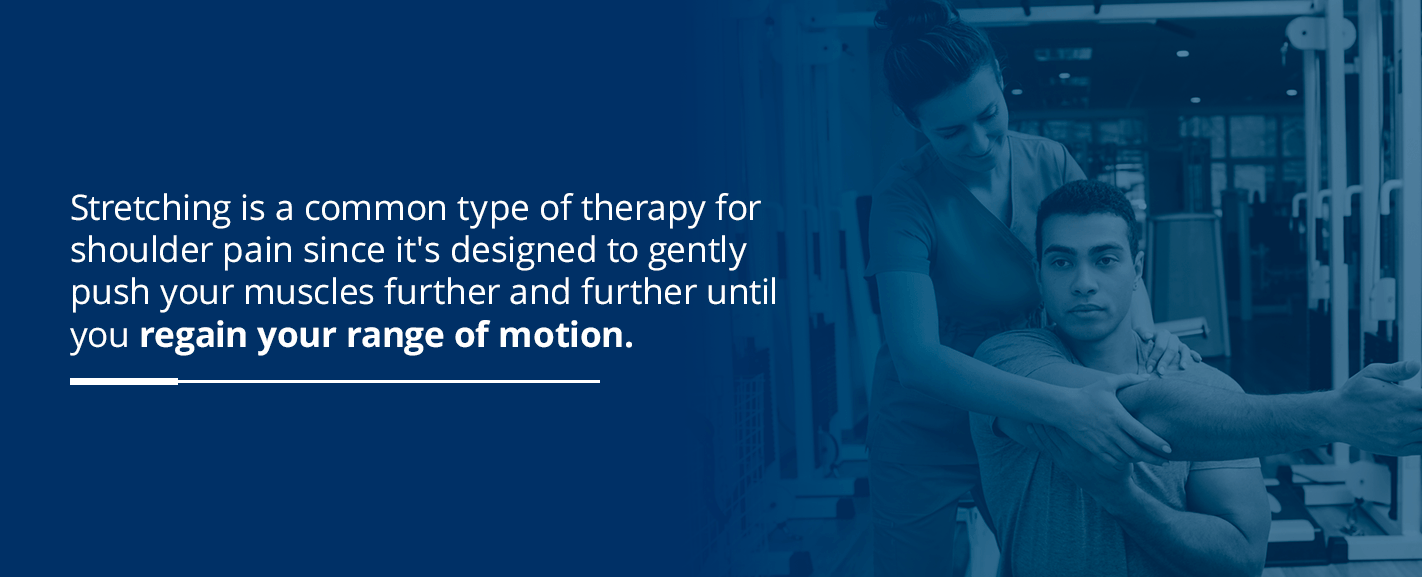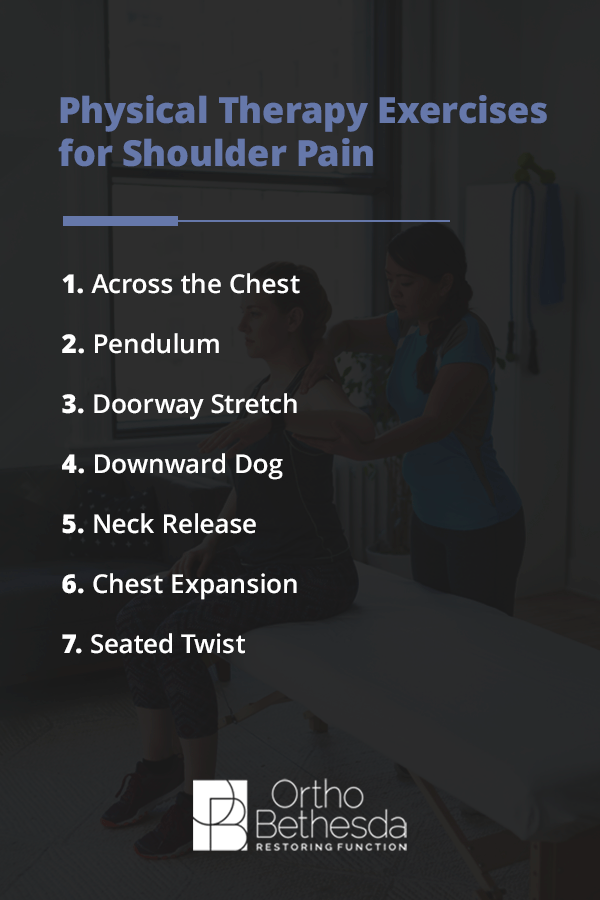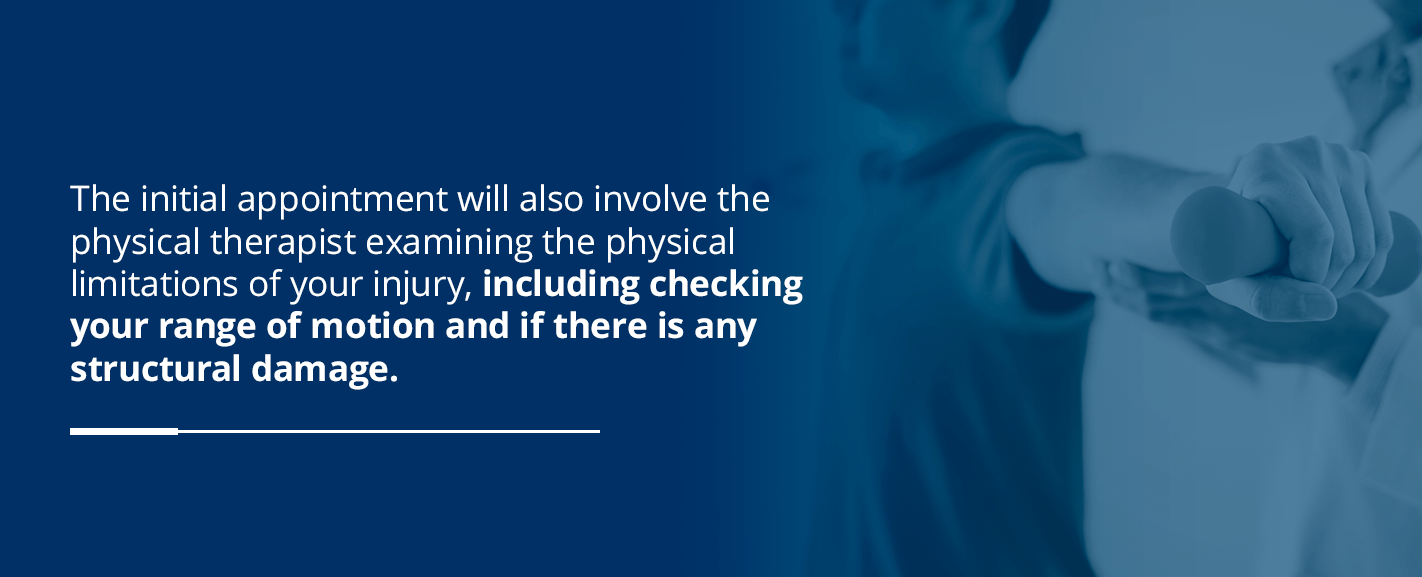
Shoulder pain is a common ailment — affecting 18% to 26% of adults — but that doesn’t mean it’s ever convenient. The shoulder has the most range of motion of all our joints, so it’s not surprising that shoulder pain and injuries are both common and incredibly uncomfortable.
The shoulder joint is made up of three main parts:
- Humerus (the upper-arm bone)
- Clavicle (the collarbone)
- Scapula (the shoulder blade)
These bones, held together by muscles, tendons and ligaments, are what allow us to do everyday tasks with ease. Because it’s one of the most-used parts of the body, it’s at a higher risk for injury, which is why it’s important to both understand how to protect the shoulders as well as how to properly treat shoulder pain and injuries.
Common Injuries that Lead to Shoulder Pain Treatment
Knowing why you’re experiencing shoulder pain is the first step to treating it, and shoulders can be injured by a variety of activities, including seemingly harmless ones, like sitting at your desk at work. The types of shoulder injuries can be neatly divided into two main categories: sudden injuries and injuries born from overuse.

Sudden Injuries
Also known as acute injuries, these can be the result of anything from tripping and landing on your shoulder to twisting the shoulder in an unnatural way. Sudden injuries can include:
- Bruises
- Injured tendons, which connect the muscle to the bone
- Injured ligaments, which help keep the shoulder joint stable
- Injured nerves
- Torn rotator cuff, which happens when any of the four tendons that cover the shoulder joint is damaged
- Strained muscles
- Broken bones
- Dislocation
After an acute shoulder injury, you’ll likely see bruising or swelling straight away, and you may feel tingling or numbness if the injury resulted in a pinched nerve or damaged blood vessel.
Overuse Injuries
Overuse injuries can be more sinister than acute injuries since they can develop slowly over time as a result of your everyday activities. They’re the result of the shoulder joint or the surrounding tissue facing excess stress, and you may not even realize anything’s wrong until you suddenly find yourself with an annoying shoulder pain to deal with. Overuse injuries can include:
- Bursitis, which is when the fluid sac cushioning and lubricating the shoulder joint becomes inflamed.
- Tendinitis, which is when the tendons become inflamed.
- Muscle strain.
- Frozen shoulder, which “freezes” your shoulder’s range of movement.
- Impingement syndrome, which is when overhead arm movements force the tendons to rub against a part of the shoulder blade, which can lead the rotator cuff tendons to become inflamed.

While acute and overuse injuries are the most common reason for shoulder pain, there are a handful of less-common injuries that can also affect your shoulder, including:
- Irregular posture
- Osteoarthritis
- Herniated disk
- Calcium buildup
- Infection
How Physical Therapy Can Help With Shoulder Pain and Shoulder Injuries
Whether it’s rotator cuff tears or other injuries to the muscles surrounding the shoulder, physical therapy for shoulder pain is often a successful, non-surgical treatment. It aims to strengthen the muscles around your shoulder to improve its function and your mobility.
Your doctor may refer you to a physical therapist to deal with your shoulder pain, and the physical therapist will examine your injury and establish the best course of treatment.

The treatment will be custom-designed to help you recover from your injury and regain your mobility, and your therapist may also include advice on how to alter your everyday activities to better support your shoulders, so you can avoid re-injury. You may also be assigned a unique home-exercise routine to follow to help you maintain your mobility once your therapy sessions are complete.
In some cases, physical therapy can prevent the need for surgery, which is especially beneficial for older adults who may not have as high a success rate with surgery. Studies show the majority of patients find physical therapy for shoulder injuries to be adequate, although the length of recovery can vary from person to person. Even in cases where surgery is inevitable, physical therapy is a great way to prepare and strengthen the body prior to and after surgery.
Physical Therapy Treatments for Shoulder Pain
Depending on the specifics of your injury, the shoulder therapy that your physical therapist will prescribe will likely include one or more of the following types of treatment:
- Ice therapy: The RICE (Rest, Ice, Compression Elevation) modal encourages icing injured spots for acute injuries. It helps reduce inflammation and swelling, which, in turn, helps reduce pain, as well.
- Heat therapy: In contrast to ice therapy, which used within the first hours of the injury, heat therapy is best used after 72 hours have passed. Like ice therapy, it’s also a painkiller and allows muscles to relax.
- Hands-on therapy: As the name implies, hands-on therapy requires the physical therapist’s help to relax the injured shoulder. With their hands, the physical therapist uses direction-specific pressure on the tissue to help it regain some of its natural mobility.
- Stretching: Stretching is a common type of therapy for shoulder pain since it’s designed to gently push your muscles further and further until you regain your range of motion. The physical therapist will likely incorporate varying levels of stretches that may target the parts of the shoulder as well as the neck and spine, depending on the injury.

- Strengthening: Strengthening is essentially another way of saying exercise since the physical therapist may recommend you practice specific strengthening exercises to reduce the pain at the injury site while also strengthening other muscles, like your core. The goal is to leave you stronger than before the injury in an attempt to prevent its reoccurrence.
- Joint mobilization: Another type of therapy in which the physical therapist’s help is necessary, joint mobilization aims to increase the injured shoulder’s mobility by stretching the joint capsule. Because it requires a thorough understanding of anatomy, it’s only performed by a trained, professional physical therapist.
- Ultrasound: A therapeutic ultrasound — not to be confused with a diagnostic ultrasound — is a type of physical therapy for shoulder pain in which the muscles, tendons and other soft tissue are treated to a session of deep heating. The heat improves the circulation in the tissue, which both alleviates pain and assists in healing the injury. Therapeutic ultrasounds also help increase the elasticity of muscles, especially in cases of frozen shoulder, in order to allow the muscles to stretch more easily and, thus, increase the range of mobility.
- Electrical stimulation: One way to strengthen the muscles of the injured shoulder is to stimulate the nerves. Sometimes, it’s used to contract muscles or reduce inflammation, but it can also be used as a way to administer medication.
- Athletic taping: Your physical therapist may opt to use athletic tape as part of your shoulder physical therapy in conjunction with other methods of therapy, such as exercises.
- Kinesiology taping: While athletic taping aims to limit movement, kinesiology taping encourages movement in a safe and secure way while increasing circulation. Depending on the type of shoulder injury you’re suffering, the physical therapist may use one of these taping methods or neither.

- Activity modification: To reduce the likelihood of your shoulder injury returning, your physical therapist will provide you with ways in which to modify the way you perform everyday activities, so your shoulders are properly supported. For example, if you’re dealing with a frozen shoulder, the physical therapist may suggest you avoid excessive rest for your shoulder.
- Workplace ergonomics: In this day and age, it’s almost impossible for some people to not be sitting at their computer desk for upwards of eight hours a day. Ergonomics is something your physical therapist will likely discuss with you — its aim is to find ways to ensure your body is getting the proper support it needs. This could be anything from doing specific exercises at your desk or investing in a new office chair.
- Home exercise program: The shoulder physical therapy exercises you do with your physical therapist will likely need to be maintained to some extent once your sessions are complete. The physical therapist will curate a set of at-home exercises to help maintain the progress you’ve made. They’ll practice the exercises with you during sessions, so you can be confident in how to do them when you get home.
Physical Therapy Exercises for Shoulder Pain
While specialized exercises are best prescribed by your physical therapist to target your specific shoulder injury, for everyday shoulder pain, there are certain exercises that you can do at home. These exercises may be part of the physical therapy treatment plan, but they’re also a good way to loosen up any tightness or tension in your shoulder and potentially help prevent an injury from occurring.
As with any exercise, it’s important to know your limits and not push yourself too hard and risk another potential injury.
1. Across the Chest
Bring one arm across your chest and hold it in place with your other hand. Release your arm and repeat with the opposite arm.
This is one of the easiest physical therapy shoulder exercises out there. It’s great to do while sitting at your desk at work, while watching TV or even as part of your daily morning stretches. It’s designed to help the shoulder joint and its muscles maintain or improve flexibility and range of motion.
2. Pendulum
With one hand resting on the back of a chair, allow your other arm to hang loosely and circle it a few times both clockwise and counter-clockwise. Then release and repeat on the opposite side. Doing this exercise a few times a day will help increase flexibility, and it’s also great for warming up your joints before a workout.
3. Doorway Stretch
Stand in any doorway with both elbows forming right angles. Step one foot forward while pressing your palms into the doorway and lean forward slightly, using your core muscles to remain steady. Repeat the move with the other foot and complete a handful of repetitions to let your chest and shoulders stretch and strengthen.
4. Downward Dog
Better known as a popular yoga pose, Downward Dog is great for stretching and strengthening the muscles in your shoulders as well as your back. Start on your hands and knees, then press into your mat with your palms to lift your hips up. Keep your knees a little bent if you need and distribute your weight among your palms and feet. Your spine should be straight, with your head pulled towards your feet, allowing your shoulders and back to properly stretch out above your head.

5. Neck Release
To give our neck and shoulder muscles a little relief, gently dip your head until your chin is touching your chest and feel the stretch in the back of your neck. Then, gently lift your head a little and tilt it to one side to allow the opposite shoulder to stretch. Then, repeat the tilt on the opposite side.
6. Chest Expansion
Standing with your arms behind you holding an exercise strap or towel, gently move your shoulder blades toward each other, opening up your chest. Lift your chin to look up. Deepen the stretch by bringing your hands closer together on the strap or towel.
This stretch is great for encouraging flexibility as well as improving your shoulders’ range of motion.
7. Seated Twist
If you practice yoga regularly, you’ll recognize the seated twist. If you’re not familiar with yoga, you can do this twist while seated on a chair. Make sure your hips are facing forward throughout the stretch and allow the stretch to begin in your lower back. Your knees should be in line with your ankles, and as you twist to one side, bring the opposite hand to rest on your thigh. Hold the stretch before gently turning to repeat it on the opposite side.
This stretch is great for your shoulders and your neck.
When to Start Shoulder Physical Therapy
It can be tricky to identify when your shoulder pain is bad enough to warrant professional medical attention, but a good rule of thumb is to see your doctor as soon as your shoulder pain is noticeable, especially if it begins to prevent you from doing everyday activities. Your doctor may recommend you see a physical therapist, but you don’t have to wait for their recommendation. If you feel you could benefit from professional physical therapy, you won’t be doing any harm by at least meeting with one, so they can examine the extent of the injury.

Ideally, sooner is better when it comes to seeing a physical therapist and beginning physical therapy for your shoulder pain. This is especially crucial if you suspect you may be suffering from an overuse injury, which often doesn’t become noticeable until the injury is more serious. The longer you leave a potential shoulder injury without adequate treatment, the worst it is likely to get. Prevention is often better than the cure, but in the case of shoulder injuries, getting physical therapy sooner rather than later can both prevent your injury from getting worse and reduce the chances that you may need surgery.
Leaving the injury too long always may end up costing you more money in the long run since a more severe injury will require more treatment. Plus, seeing a professional physical therapist who is well-versed in human anatomy is an excellent way to help you fix any problematic activities or habits you may have, allowing you to both heal and successfully prevent future injuries.
So, as soon as you suspect you may be dealing with shoulder pain or a shoulder injury, it’s a good idea to seek medical advice.
What to Expect From a Physical Therapy Appointment
If you’ve never been to a physical therapist for shoulder pain or otherwise, you may feel a bit nervous, especially if you don’t know what to expect at all. The very first physical therapy appointment likely won’t be at all like subsequent appointments. In the initial appointment, you’ll talk with the physical therapist about your shoulder pain or shoulder injury, including how you got it. The physical therapist will also discuss any physical limitations you have as a result of your injury and what goals you hope to achieve throughout the course of treatment.
The initial appointment will also involve the physical therapist examining the physical limitations of your injury, including checking your range of motion and if there is any structural damage. It’s a good idea to wear comfortable, casual clothes for the appointment, so you’re able to move with ease and the physical therapist can conduct their examination properly. If your appointment is following an event, such a work, which makes it difficult for you to dress in casual clothing, the physical therapist can sometimes provide clothing to help access the injured body part with ease. You can also bring along a change of clothes to wear during the appointment.

Based on the physical exam, the physical therapist may recommend other tests to rule out the possibility of other conditions. For example, if you see a physical therapist for your shoulder pain, they may recommend tests on your back or hands as well. The goal is to make sure the physical therapy targets the right injury and to avoid the opportunity to potentially miss a bigger issue of which shoulder pain may only be one symptom.
All these questions and examinations will help the physical therapist get a good idea of your injury as well as provide the guidelines to develop a curated treatment plan for you. The treatment plan will consist of several types of physical therapy that will help your shoulder injury heal most effectively. It can be a combination of several therapies, but each treatment plan includes some level of at-home exercises. It’s unlikely you’ll be visiting the physical therapist every single day, so it’s important to stick to the schedule for at-home exercises to avoid undoing any progress you will have made in sessions.
The physical therapist is also available to answer any questions or address any concerns you may have, whether it’s about your injury, your everyday activities or the ways in which you can make your everyday life more ergonomic.
Get Professional Physical Therapy at OrthoBethesda

Any sort of pain is a nuisance, especially when it prevents you from living your life. At OrthoBethesda, we believe surgery should be the last option, which is why our team of trained professions provides conservative treatments, including physical therapy for shoulder pain and injuries.
We’re proud to offer a comfortable and inviting environment in which you can feel relaxed and at ease. Our team of experienced rehabilitation professionals will take the time to discuss your injury with you as well as any concerns you may have. We’ll work to establish the best treatment plan for you, keeping your comfort and well-being top of mind, so you can return to living a healthy and active lifestyle.
We accept most major insurance, and we’re happy to answer any questions or concerns you may have about coverage. We also make sure to confirm approval for your insurance plan ahead of your appointment, so you can begin the road to recovery with peace of mind.
Get in touch to book an appointment by calling (301) 530-1010.
Related Content
- How Much Does Physical Therapy Cost?
- The Role of Medical Imaging in Physical Therapy
- What Makes a Good Physical Therapist?
- What to Wear to Your Physical Therapy Appointment
- 4 Common Reasons Why Physical Therapy Is Important
- How to Become a Physical Therapy Assistant
- Making the Most of Virtual Physical Therapy
- Occupational Therapy vs. Physical Therapy
- Should You Get Physical Therapy After a Concussion?
- Top Reasons You Should See a Certifed Hand Therapist
